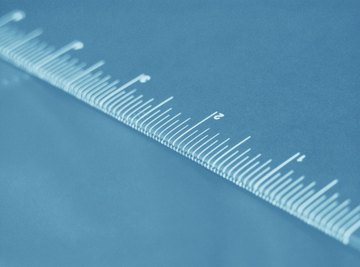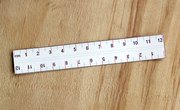
Rulers are a great tool for learning about, and taking, real-world measurements in a variety of units. Most rulers in the United States have markings on two sides: One side of the ruler has lines for measuring inches and feet, while the other side has lines for measuring millimeters and centimeters. The lines on the centimeter ruler side will be closer together than those on the inches/feet side. The smallest marks on that side, which denote millimeters, are so close together that they aren't numbered – but you can still count them.
Start With Ruler Counting
Before you actually start measuring things with your ruler, the first step is to master the process of ruler counting. Locate the zero end of the ruler, and then count each individual mark along the edge of the ruler. Each mark represents 1 millimeter or mm, so counting five marks is the same as counting 5 millimeters, counting 10 marks is the same as counting 10 millimeters and so on.
Start Measuring With Your Ruler
Once you're comfortable with ruler counting in millimeters, it's time to transition to taking actual measurements. Keep in mind that because your ruler is straight, it can only be used to measure straight distances.
Place the flat end of the ruler against whatever it is you're measuring, and line the zero mark on the ruler up with one end of the object to be measured. Next, starting from the zero end of the ruler, count the marks along the ruler just as you did for "ruler counting."
Once you reach the other edge of the object you're measuring, stop. Remember that however many marks you've counted along the ruler equal the number of millimeters you've measured. So if you counted 23 marks to reach the far end of the object, it's 23 millimeters long; if you counted 46 marks to reach the far end of the object, it's 46 millimeters long; and so on.
Tips for Taking Ruler Measurements
Although you could just count millimeters along your ruler from one end to another, there's an easier way. Instead of counting every millimeter, count the larger marks (on the same side of the ruler) that represent centimeters, until you're close to – but not past – the edge of whatever you're measuring. Multiply the number of centimeters you counted by 10, and then keep counting millimeters from there.
Why does this work? It's because each centimeter is the same as 10 millimeters. (You can confirm this by counting the millimeter marks in between centimeter marks on your ruler.) So when you count centimeters, it's like counting by tens in millimeters. Multiplying the number of centimeters by 10 converts the measurement back into millimeter form. If you want to skip that step, you can also just count by tens, adding an extra 10 for each centimeter mark you pass on the ruler.
Counting the Centimeter Marks
If whatever you're measuring is more than 10 or 20 millimeters long, you may be asked to measure it in centimeters instead. You can do this by counting along the ruler's centimeter marks as just described. Once you reach the centimeter mark nearest the edge of your object (but not past it), stop and write down how many centimeters you've counted, followed by a decimal point.
Next, count how many millimeter marks remain between the last centimeter mark and the edge of your object being measured. (The result will be 9 or fewer – if you counted up to 10 millimeters, you'd reach the next centimeter mark.) Write this new number down to the right of the decimal point. The answer will be your measurement in centimeters.
So, for example, if you measure an object that's 4 centimeters long, and then another 3 millimeters, its ultimate length is 4.3 centimeters long.
Tips
This works because each millimeter is equal to 1 centimeter, so each millimeter mark you count along the ruler is equal to 0.1 centimeter.
Converting Between Millimeters and Centimeters
Last but not least, if you have a measurement in millimeters but want to compare it to other measurements taken in centimeters, you should convert the millimeter measurement into centimeters. (That way you can compare similar units – it's like comparing apples to apples, instead of trying to compare apples to oranges.)
To convert from millimeters to centimeters, divide your measurement by 10. So for example, if you measured 52 millimeters along the ruler, you'd divide by 10 to get the equivalent in centimeters:
Did you notice that you can get the same result by simply shifting the decimal point one space to the left? That gives you the same result as dividing by 10.
If you want to convert from centimeters to millimeters, do the reverse: Multiply by 10 or, for a handy shortcut, move the decimal point one spot to the right. For example, if you had measured something that was 7.9 centimeters long, you could multiply that by 10 to get the result in millimeters:
References
About the Author
Lisa studied mathematics at the University of Alaska, Anchorage, and spent several years tutoring high school and university students through scary -- but fun! -- math subjects like algebra and calculus.
Photo Credits
Medioimages/Photodisc/Photodisc/Getty Images
